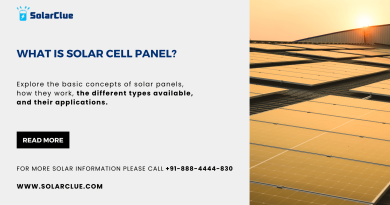What Is The Difference Between Photovoltaic And Solar Panels?
Solar energy has become a cornerstone of renewable energy solutions, but not all solar panels are created equal. Two primary types of solar panels—photovoltaic (PV) panels and solar thermal panels—serve different purposes and operate on distinct principles. This blog post will explain the differences between these two technologies, their applications, and the advantages and disadvantages of each.
Table of Contents
- 1 The Basics of Photovoltaic (PV) Technology
- 1.1 The Concept of Solar Thermal Energy
- 1.2 Comparison of Photovoltaic (PV) Panels and Solar Thermal Panels
- 1.3 Comparing the Efficiency of PV and Solar Thermal Panels
- 1.4 The Best Applications for Each Type of Panel
- 1.5 The Environmental Impact of PV and Solar Thermal Systems
- 1.6 The Future of PV and Solar Thermal Technologies
- 1.7 Common Misconceptions About PV and Solar Thermal Panels
- 1.8 The Potential for Combining PV and Solar Thermal Systems
- 1.9 The Role of Government Policies in Promoting PV and Solar Thermal Adoption
- 1.10 Conclusion
- 1.11 FAQ Section
The Basics of Photovoltaic (PV) Technology
How PV Panels Work:
- Photovoltaic Effect: PV panels generate electricity by converting sunlight directly into electrical energy through the photovoltaic effect. When sunlight strikes the semiconductor material in the PV cells, typically silicon, it excites electrons, creating an electric current.
- Direct Electricity Production: The electricity generated by PV panels can be used immediately, stored in batteries, or fed into the grid.
The Concept of Solar Thermal Energy
How Solar Thermal Panels Work:
- Heat Collection: Solar thermal panels, also known as solar collectors, use sunlight to heat a fluid (such as water or antifreeze) that circulates through the system. The heat collected is then used for domestic hot water, space heating, or even to generate electricity through a steam turbine in larger installations.
- Indirect Energy Production: Unlike PV panels, solar thermal panels don’t generate electricity directly. They are designed to harness solar energy as heat, which is then used for various thermal applications.
Comparison of Photovoltaic (PV) Panels and Solar Thermal Panels
| Aspect | Photovoltaic (PV) Panels | Solar Thermal Panels |
|---|---|---|
| Energy Conversion | Converts sunlight directly into electricity | Converts sunlight into thermal energy (heat) |
| Primary Application | Electricity generation | Heating (water, air, or other fluids) |
| Efficiency | Typically 15-22% | 60-70% for heating applications |
| Installation Complexity | Moderate (depends on system size) | Varies (from simple domestic hot water systems to complex installations) |
| Cost | Higher upfront cost, declining with scale | Lower cost for small systems, higher for larger systems |
| Environmental Impact | Low (no emissions, uses renewable energy) | Low (no emissions, uses renewable energy) |
| Maintenance | Low to moderate (cleaning, inverter checks) | Low to moderate (fluid checks, collector maintenance) |
| Best Applications | Residential, commercial, industrial power generation | Domestic hot water, space heating, industrial processes |
Comparing the Efficiency of PV and Solar Thermal Panels
Efficiency Metrics:
- PV Panels: PV panels typically convert 15-22% of the sunlight they receive into electricity. Their efficiency depends on factors like panel quality, installation angle, and sunlight intensity.
- Solar Thermal Panels: Solar thermal panels are more efficient in converting sunlight into heat, with efficiencies ranging from 60-70%. This is because converting sunlight to heat is a less energy-intensive process compared to converting sunlight to electricity.
The Best Applications for Each Type of Panel
PV Panels:
- Electricity Generation: PV panels are ideal for generating electricity for homes, businesses, and industrial facilities. They are also used in off-grid systems and remote locations where access to the electricity grid is limited.
Solar Thermal Panels:
- Heating Applications: Solar thermal panels are best suited for applications that require heat, such as domestic hot water systems, space heating, and industrial processes like water heating or drying.
- Large-Scale Solar Thermal Plants: In some cases, solar thermal panels are used in large-scale solar power plants to generate electricity through steam turbines, though this is less common compared to PV installations.
The Environmental Impact of PV and Solar Thermal Systems
Low Environmental Impact:
- Both PV and solar thermal systems have a low environmental impact, as they use renewable energy from the sun. They do not emit greenhouse gases during operation, making them a sustainable choice for reducing carbon footprints.
Resource Use:
- PV Panels: The manufacturing of PV panels involves the use of raw materials like silicon, as well as energy-intensive processes. However, the environmental benefits over the lifetime of the panels far outweigh the initial resource use.
- Solar Thermal Panels: Solar thermal systems also require materials like glass and metals, but they generally have a lower resource impact compared to PV panels, particularly for smaller installations.
The Future of PV and Solar Thermal Technologies
Technological Advancements:
- PV Technology: Ongoing research aims to increase the efficiency and affordability of PV panels, with innovations like perovskite cells and bifacial panels showing promise.
- Solar Thermal Technology: Advances in materials and system design are improving the efficiency and scalability of solar thermal systems, particularly for industrial applications.
Hybrid Systems:
- The future may see more widespread adoption of hybrid systems that combine PV and solar thermal technologies, maximizing the energy output from a single installation by producing both electricity and heat.
Common Misconceptions About PV and Solar Thermal Panels
Myth: Solar panels are only for generating electricity.
- Fact: While PV panels generate electricity, solar thermal panels are specifically designed for heating applications.
Myth: Solar thermal systems are outdated compared to PV systems.
- Fact: Solar thermal systems are still highly effective and efficient for heating applications and are not outdated. They remain a crucial part of renewable energy solutions.
The Potential for Combining PV and Solar Thermal Systems
Integrated Solutions:
- PV-Thermal (PVT) Systems: These systems combine PV and solar thermal technologies in a single panel, allowing for the simultaneous production of electricity and heat. This can improve overall system efficiency and maximize the use of available space.
Applications:
- Residential and Commercial: PVT systems are particularly well-suited for buildings with limited roof space, where maximizing energy production from both electricity and heat is desirable.
The Role of Government Policies in Promoting PV and Solar Thermal Adoption
Incentives and Subsidies:
- Government Support: Many governments offer incentives, subsidies, and tax credits to promote the adoption of both PV and solar thermal technologies. These policies help reduce the initial investment cost and encourage wider adoption.
Regulations:
- Building Codes: Some regions have building codes that require the integration of renewable energy systems, including solar thermal, in new constructions, further driving market growth.
Conclusion
Photovoltaic (PV) panels and solar thermal panels are both essential technologies in the renewable energy landscape, each serving different purposes and applications. While PV panels excel in generating electricity, solar thermal panels are unmatched in their ability to harness heat from the sun for various heating applications. Understanding the differences between these technologies, their advantages, and their potential applications can help you make informed decisions about incorporating solar energy into your life or business.
Here at SolarClue®, we offer a smart, practical, and “beautiful” solution. You will be answered for all the questions related to Solar.
We provide all kinds of brands that are the Best Solar panels in India.
If you are the one who is planning for the solar power system. Don’t hesitate to contact our team!
Looking forward to empowering you with solar energy, just like hundreds of our other clients!
FAQ Section
1. What is the main difference between photovoltaic (PV) panels and solar thermal panels?
PV panels convert sunlight directly into electricity, while solar thermal panels convert sunlight into heat for applications like water heating or space heating.
2. Which type of panel is more efficient?
Solar thermal panels are generally more efficient at converting sunlight into heat (60-70%) compared to PV panels, which convert sunlight into electricity at an efficiency of 15-22%.
3. Can PV and solar thermal panels be used together?
Yes, hybrid systems known as PV-Thermal (PVT) panels combine both technologies in a single system, allowing for the production of both electricity and heat from the same installation.
4. What are the best applications for each type of panel?
PV panels are best for generating electricity, suitable for residential, commercial, and industrial uses. Solar thermal panels are ideal for heating applications, such as domestic hot water, space heating, and industrial processes.
5. How do government policies impact the adoption of PV and solar thermal technologies?
Government policies, including incentives, subsidies, and regulations, play a crucial role in promoting the adoption of both PV and solar thermal systems by reducing costs and encouraging integration into buildings.



mujhe solar panel house roof par lagana h
Please send me your contact no. My person will call you for the same and will explain you each and every point.